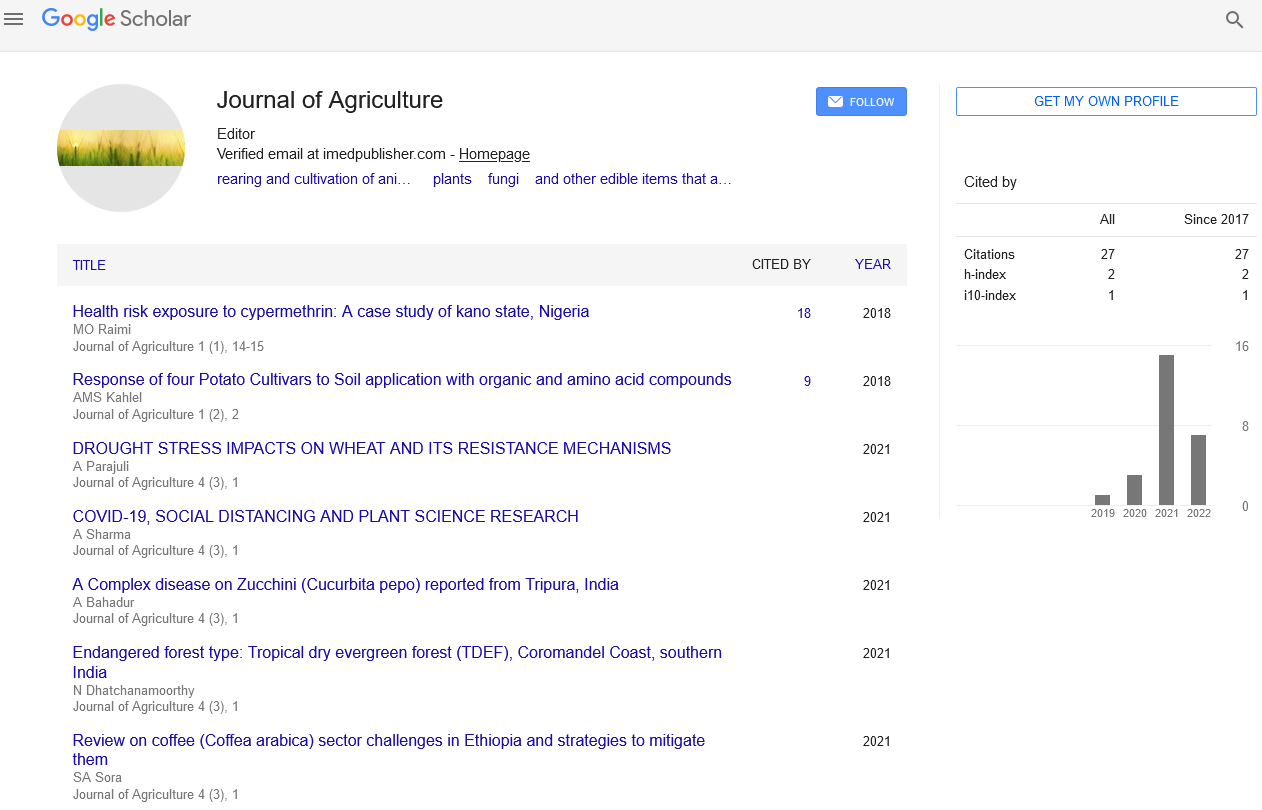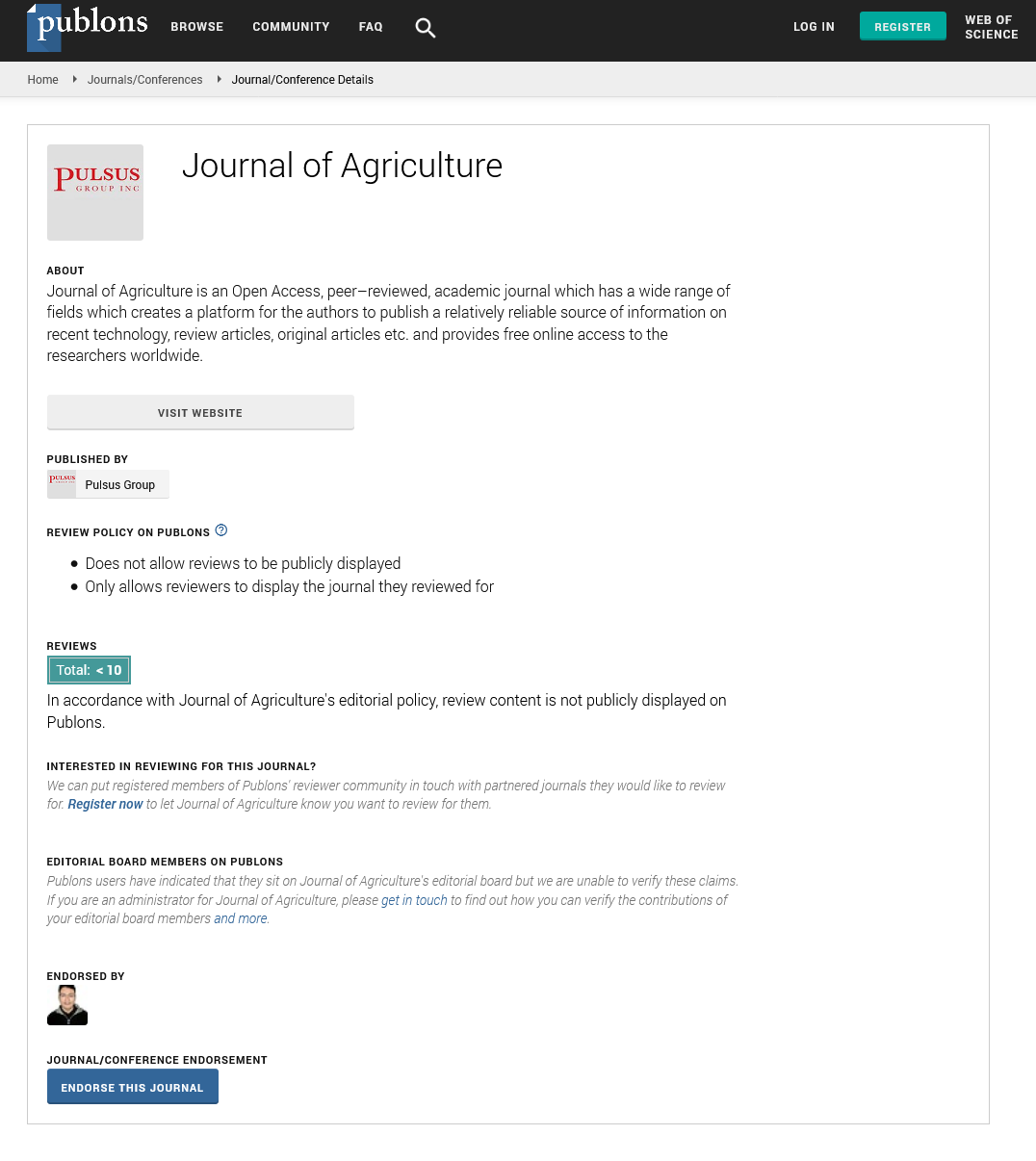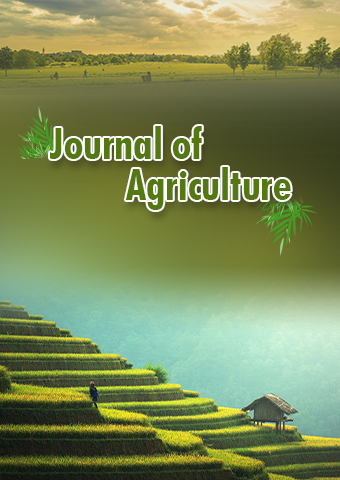Mini Review - Journal of Agriculture (2023) Volume 6, Issue 2
Retaliation of Initiation and Seedling Growth Of
Ramesh Acharya*
Department of Agriculture, University Putra Malaysia, Malaysia
- *Corresponding Author:
- Ramesh Acharya
Department of Agriculture, University Putra Malaysia, Malaysia
E-mail: Rameshacharya1@gmail.com
Abstract
In this system, myriad Pro he nature of the planting substrate plays a significant role in the germination, establishment, and growth of the plant. In the current experiment, the germination and growth of the Jute plant in an aquaponics system with tilapia fish was investigated using three different substrate types: gravel, rice husk, and palm kernel shell. Five hundred-litter plastic tanks containing tilapia fingerlings at initial stocking densities of 250 fish m−3 were used. One gram of Jute seed was sown in a 1 m2 planting trough, which contained the three substrates separately in triplicates The germination percentage of the jute plant on gravel substrate (84%) and rice husk (72%) was significantly higher (P < 0.05)compared to the palm kernel shell (55%) The rates of growth in height (centimetres per day) of jute plant and fresh shoot biomass yield were significantly lower on palm kernel substrate (P < 0.05).
Keywords
Biomass • Germination • Jews mallow • Organic • Chemical fertilizers • Growth • Yield • Leaf content
Introduction The modern world has made aquaponics a suitable substitute for food production aquaponics have made it an acceptable alternative to the production of fish and vegetables, whether in soilless or using planting substrates in aquaponics, many of the cultural fish species have been used in combination with different vegetable species [1]. Production and yield of fish have been found to depend on the density and filtration density is among the important factors that affect fish growth, survival, and production performance in the aquaponics system. Optimal density will maximize the utilization of the fish culture system, water, and financial resources .The production of vegetables in the system is also influenced byfactors such as fish density, plant substrate type, and water flow rates [2]. The bed is commonly used in simple aquaponics systems, and it can provide bio filtration and anchorage for efficient plant growth products, especially fibre, are of economic importance as their exportation has been renowned to contribute to the economy of countries like India and Bangladesh in addition to domestic consumption as food in many other countries. Jute green leafy C Furthermore, the suitability of locally available raw materials as substrate in the aquaponics system was investigated. Some growing media have found their use in aquaponics, ranging from a soilless mix of peat and perlite; cocoanut shell fibre, clay pebbles, pruning waste compost, and gravel [3]. All thesecould be biodegradable or no biodegradable. Some organic substitutes, such as tree bark, have been demonstrated to be problematic because they absorb plant-growth nutrients and keep them from getting to the plants. Finding other waste products to replace synthetic materials plant stage that determines seedling establishment and plant growth on the substrate kernel shell substrates
Materials and Methods
Aquaponics setup
This experiment was carried out in the biological garden of UmaruMusa Yaradua University between November 2019 and February 2020using an existing aquaponics system. The system is comprised of rectangular pan (1 m2 surface area and 0.2 m deep) as a planting trough. The builder’s grade gravel (GBS), rice husk (RHS), and crushed palm kernel shell (PKS) were used separately in triplicates as a planting substrate. The planting bed also served as a mechanical filter in the setup [4]. Aeration was provided using an RS- 390 air pump at a rate of 3.5 Limn− 1. Hamish® aquarium pumps were used to connect water to the planting bed. The troughs were arranged in such a way that water drained directly into the fish tank through perforated holes. The fish Katina, and stocked in each tank at a density of250 fish− 3 in triplicates. The fish were fed twice-daily with a floating pellet diet, Top Feed Aqua containing 37% crude protein at the rate of5% of their body weight. The mixture was evenly However, the plants this has also been reported to favour nitrification.
Data collection and analysis
Germination percentage (GP) was calculated by counting the number of germinated seeds and dividing them by the total number of seeds planted, expressed in percentage.GP = Number of germinated seeds × 100Number seeds sown the coefficient of velocity of germination (CVG) was determined following CVG =Σin × 100ΣDi nowhere: CVG: Coefficient of velocity of germination; in = number of germinated seeds in the it hours [5]. Time to the collection of in data. The final height of the Jute plants was recorded at 60 days after obtained after cutting the plant from the ground level and weighing it immediately the pH was measured using a Met Rohm Herisau E520 pH meter. Incubation method at 20 oC for five days. The total ammonia nitrate concentration was determined using the spectrophotometric method .The total length (TL cm) and wet weight (WW g) of the fish from all number of survivals were determined and expressed [6].
Statistical analysis
Germination percentages, coefficient of velocity of germination, fresh shoot biomass, fish weight gain, and percentage survival. A comparison between means was made using the least significant difference (LSD) at the 0.05 probability level [7].
Results and Discussion
Germination and growth of jute
The Adobe Garamond Pro germination percentages (GP) of Jute seed and the coefficient of velocity of germination (CVG) were significantly influenced by substrate The highest GP after 72 h (84%) 72 HAS (1.17) was obtained in GBS, while the lowest value (0.76) was obtained in PKS RHS compared to PKS. In recent times, aquaponics has been widely advocated as an eco-friendly farming system for fish and vegetable production [8]. However, due to the cost and availability of materials, especially in the vegetable planting components, there is a need for alternative planting substrates.This is also the trend in floriculture [9]. The findings in the current research demonstrate the potential of rice husk as an aquaponics the germination percentage in RHS is comparable to that in GBS with no significant difference. Chatham and Johnson found that germination conditions and stress for growing Jute in the aquaponics environment chemical properties for specific crop growing conditions [10]. Air-filled pores, which allow for gas exchange and drainage between the root’s internal and external environment, are considered important in horticulture ditto aquaponics the rate of germination of C Jute dormancy is well acknowledged with slow germination. There corded germination rate of both GBS and RHS is sufficient to achieve the required uniformity of Jute seedling emergence in the aquaponics environment. The PKS is also expected to possess sufficient porosity for gas exchange, but its non-uniform arrangement and its level ofcompactness could encourage seed deterioration because the decreased.
References
- Smith JG, Christophers AJ. Phenoxy herbicides and chlorophenols: a case control study on soft tissue sarcoma and malignant lymphoma. Br J Cancer. 65, 442-448 (1992).
- Hoar SK, Blair A, Holmes FF et al. Agricultural herbicide use and risk of lymphoma and soft-tissue sarcoma. JAMA. 256, 1141-1147 (1986).
- Johnson KJ, Carozza SE, Chow EJ et al. Parental age and risk of childhood cancer: a pooled analysis. Epidemiology. 20, 475-483 (2009).
- Merletti F, Richiardi L, Bertoni F et al. Occupational factors and risk of adult bone sarcomas: a multicentric case–control study in Europe. Int J Cancer.118, 721-727 (2006).
- Kedes DH, Operskalski E, Busch M et al. The seroepidemiology of human herpesvirus 8 (Kaposi's sarcoma-associated herpesvirus): distribution of infection in KS risk groups and evidence for sexual transmission. Nat Med 2, 918-924 (1996).
- Lahat G, Lazar A, Lev D et al. Sarcoma epidemiology and etiology: potential environmental and genetic factors. Surg Clin North Am. 88, 451-481 9 (2008).
- Pukkala E. Occupation and cancer - follow-up of 15 million people in five Nordic countries. Acta Oncol. 48, 646-790 (2009).
- Woods JS, Polissar L, Severson RK et al. Soft tissue sarcoma and non-Hodgkin's lymphoma in relation to phenoxyherbicide and chlorinated phenol exposure in western Washington. J Natl Cancer Inst. 78, 899-910 (1987).
- Hardell L, Eriksson M The association between soft tissue sarcomas and exposure to phenoxyacetic acids, A new case-referent study. Cancer. 62, 652-656 (1988).
- Wingren G, Fredrikson M, Brage HN et al. Soft tissue sarcoma and occupational exposures. Cancer. 66, 806-811 (1990).
Indexed at, Crossref, Google Scholar
Indexed at, Crossref, Google Scholar
Indexed at, Crossref, Google Scholar
Indexed at, Crossref, Google Scholar
Indexed at, Crossref, Google Scholar
Indexed at, Crossref, Google Scholar
Indexed at, Crossref, Google Scholar
Indexed at, Crossref, Google Scholar
Indexed at, Crossref, Google Scholar


